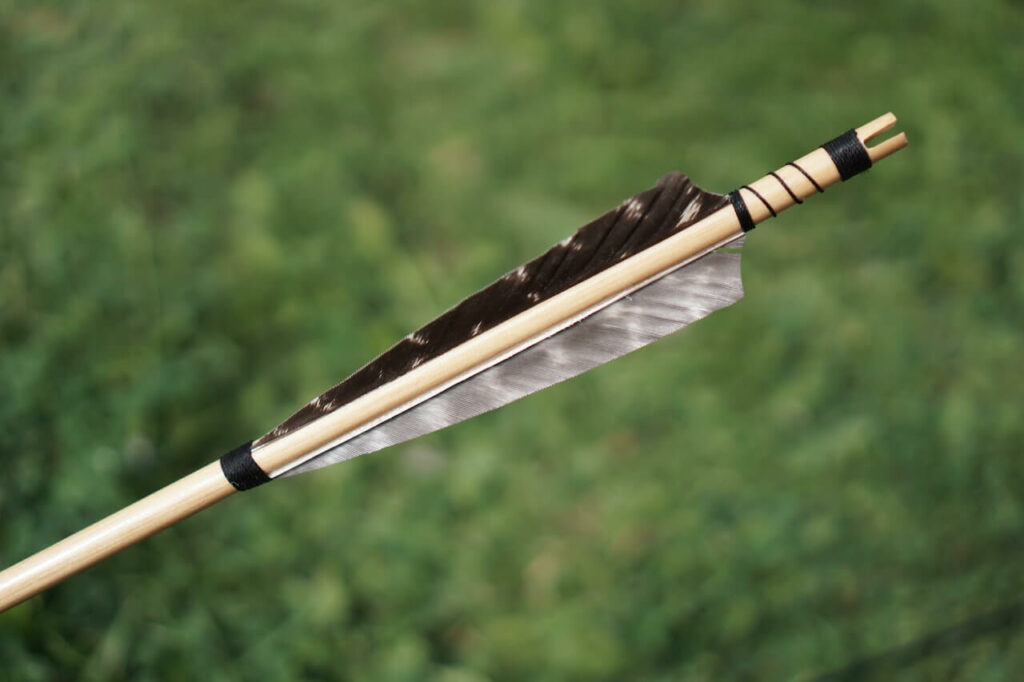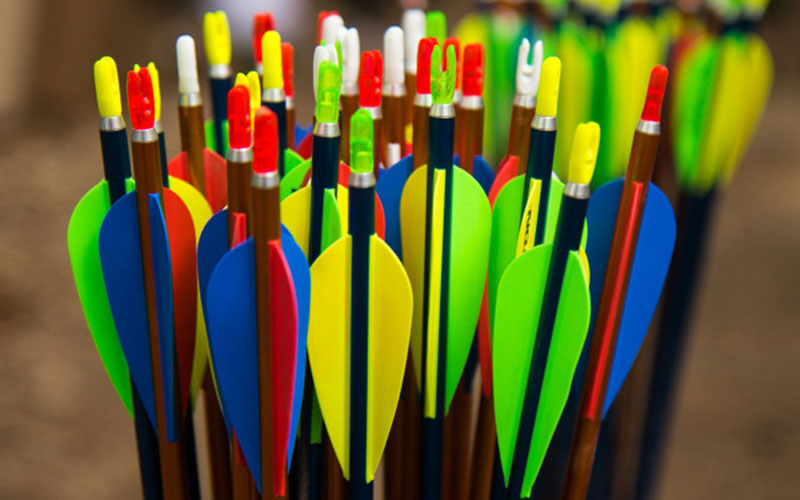No matter what style of archery you happen to stumble upon: indoor, outdoor target, outdoor 3D, traditional, or hunting; you will at some point be faced with the decision of whether to use feathers or vanes. Which shape, size, and weight are all questions that need to be answered no matter which type you choose to go with.
In this article, we’ll break down the pros and cons of each and whether or not feathers or vanes are right for your purpose in archery.
In general, if you are using an elevated rest, then you can use feathers or vanes. But if you’re shooting off the shelf, then you should only use feathers as they are soft and compress against the bow allowing the arrow to pass smoothly. Vanes are stiffer and can impact the riser on release, affecting the arrow’s trajectory.
Every archer should make their own decision based on their purpose with archery, and their own individual goals which we’ll get to a little later. First, let’s look at whether you should choose feathers or vanes in a little more detail.
Should You Use Feathers Or Vanes?
Feathers and vanes both fall under the title of fletchings. The purpose of fletchings is to spin and stabilise the arrow, as well as align the arrow to the target while in flight. They perform the same job as propellers on a plane.
The general guidelines for using either one are pretty straightforward. If you use an elevated rest then you will be able to use both feathers and vanes.

If you only shoot off the shelf, you will only be able to use feathers.
Feathers
The reason for this is that feathers are soft, so when they make contact with the bow, they will compress, thus allowing the arrow to pass over the shelf without damaging the arrow or the shelf. There will also be minimal effect on the arrow’s flight path.
The odd-coloured index or cock feather should always point out so that the arrow doesn’t contact the bow on release.
Feathers can be cut in a variety of heights and lengths depending on how much or how little drag you require. For example, a low profile feather fletching of 4 inches will provide less drag than the standard profile of 3 inches.
Another point to mention when using real feathers is that each of the three fletchings needs to be from the same wing of the bird, otherwise, your arrows won’t fly correctly.
Experimenting to find the optimum set-up between the right amount of stabilisation and the least amount of drag is going to be part of the fun!
Vanes
Vanes, on the other hand, because they are made from either plastic or rubber, will not compress against the bow. The rigidity of the vane will cause the flight of the arrow to be affected if it comes into contact with the riser.

Elevated rests are not rigid and will move as the arrow leaves the string. This will allow the vanes to pass without contacting the bow.
If you buy arrows off the shelf, then they are probably going to be fletched with plastic vanes. Vanes are cheaper to buy in bulk and are easy for the shop to put together and they often come pre-made straight from the factory.
You can also get more advanced performance vanes such as Spin Wings, XS vanes or Elivanes etc. These particular types of vanes are more personalised for the archer and are favoured by more serious competitive shooters.
If you’re using a Whisker Biscuit rest which completely encloses the arrow and avoids the need for fletch clearance, you can still use feathers. Just make sure to apply glue to the leading edge to minimise wear and tear.
There is also something called a Trad Vane, which is a hybrid of both feather and vane that you can shoot off the shelf. It’s still made out of rubber but is light and flexible enough that it will compress enough to allow the arrow to pass without disrupting its flight path.
If you had to choose between feathers and vanes, you’re probably better off getting the ones that are most readily available. Vanes tend to be stocked in greater numbers and a variety of colours than feathers.
What is The Purpose of Fletching?
An arrow never leaves the bow in a perfectly straight line. There is always a slight angle. This is down to something called the archer’s paradox.
The job of the fletchings is to correct that flight path as the arrow flies towards the target. There will also be an amount of ‘fishtailing’, or ‘porpoising’, depending on the tune of the arrow shaft.
So in theory, a perfectly tuned arrow with the perfect fletching; matched perfectly to the bow and shot by the best archer, should, in fact, come out of the bow perfectly straight every single time with, or without fletching.
For more on arrow tuning, you might be interested in this article that I wrote.
What Performs Better, Feathers or Vanes?
The performance of the fletches largely depends on the size of the fletchings.
Feather fletchings tend to have a larger surface area which means that they can grab more air. This corrects the arrow’s flight much sooner out of the bow.
But the larger the fletches are, the more drag there is likely to be which will affect velocity and performance over longer distances.
Bow hunters who shoot with expandable broadheads sometimes choose larger feather fletchings because of the additional control and guidance they can give through their larger surface area.

You can also purchase artificial feathers which will have greater longevity, but if you can’t locate them, then you can strengthen feather fletches by adding a tiny bit of glue along the leading edge of the feather to give it more durability.
Vanes, however, being much smaller will create less drag and perform much better over longer distances due to the higher velocity, but the plastic vanes will take longer to correct the arrow out of the bow.
One other thing to consider here is the weight that each type of fletching adds to your arrow.
Recurve shooters tend to favour the higher performance vanes, such as Spin Wings or Elivanes over rubber vanes because of how little weight they add to the arrow.
The archer still gets the distance plus the added control with performance vanes, and the lighter vanes will make for a weaker spine which will allow the arrow to absorb any errors or inconsistencies from the release.
Left Wing Or Right Wing Feathers?
The only real difference between left and right-wing feathers is the angle at which the feather comes off the quill.
If you’re fletching your own arrows, then the only real consideration you need to make is which direction you want to make your arrows twist.
If that isn’t a major concern, then left or right-wing feathers are going to be equally ok. Just don’t mix and max! Make sure that each fletching is from the same wing.
Helical Twist, Offset Or Straight Vanes?
For those who aren’t familiar with what a helical twist is, it refers to when the vanes are fletched onto the arrow at an angle so that they appear to wrap around the arrow shaft.
What this does is provide even greater stability to the arrow because the helical placement of the vanes grabs the air much more efficiently than a straight vane.
Offset vanes also provide more stability than straight vanes but will not spin as much as helical vanes.
Helical vanes are not exclusive to plastic vanes. You can also fletch arrows with a helical twist as well as an offset placement.
Helical fletches will work particularly well with low draw weights and low speed bows.
Feathers: Pros and Cons
Pros
- More forgiving
- Can cut to your own preference
- Large surface area stabilises the arrow quickly
- Great over short distances
- Durable
Cons
- Generally only suited to indoor archery
- Not wet weather resistant
- The large surface creates a lot of drag, reducing the arrow’s velocity
- Not great over longer distances
- Not consistent in size and weight
- Have to be fletched according to wing direction
Best Suited To
- Beginners
- Traditionalists
- Recreational Shooters
- Bow hunters
Indoor and traditional archers tend to favour the softness and the forgiving nature of feathers. For this reason, they are also particularly suited to beginners.
Vanes: Pros and Cons
Pros
- Weatherproof
- Great for distance shooting
- More accuracy
- Consistent size and weight
- Can be fletched in any direction
- Cheaper to buy in bulk
Cons
- Non-customisable
- Break/Tear easily
- Less forgiving
Best Suited To
- Sport/Target shooters
- Bow Hunters
- Compound shooters
- High draw weights
- Olympic Shooters
As the industry standard for competition shooting, vanes are absolutely the best when it comes to accuracy and distance.
Conclusion
When it comes to choosing the fletches for your arrows you really do have a ton of options, no matter what style of archery you decide to shoot.
If you’re still on the fence about what is best suited for your purpose with archery, then you should be experimenting with both feathers and vanes, but just to sum up…
For traditional archers, there is a massive variety of sizes, cuts and colours of feather fletchings to choose from. You can even take it to the next level by learning how to fletch your own arrows for even more personalisation.
For target shooters and competitive archers who need more accuracy and endurance, there is also an unlimited choice when it comes to selecting your vanes. They are more readily available and cheaper due to the higher potential for damage.

0 Comments